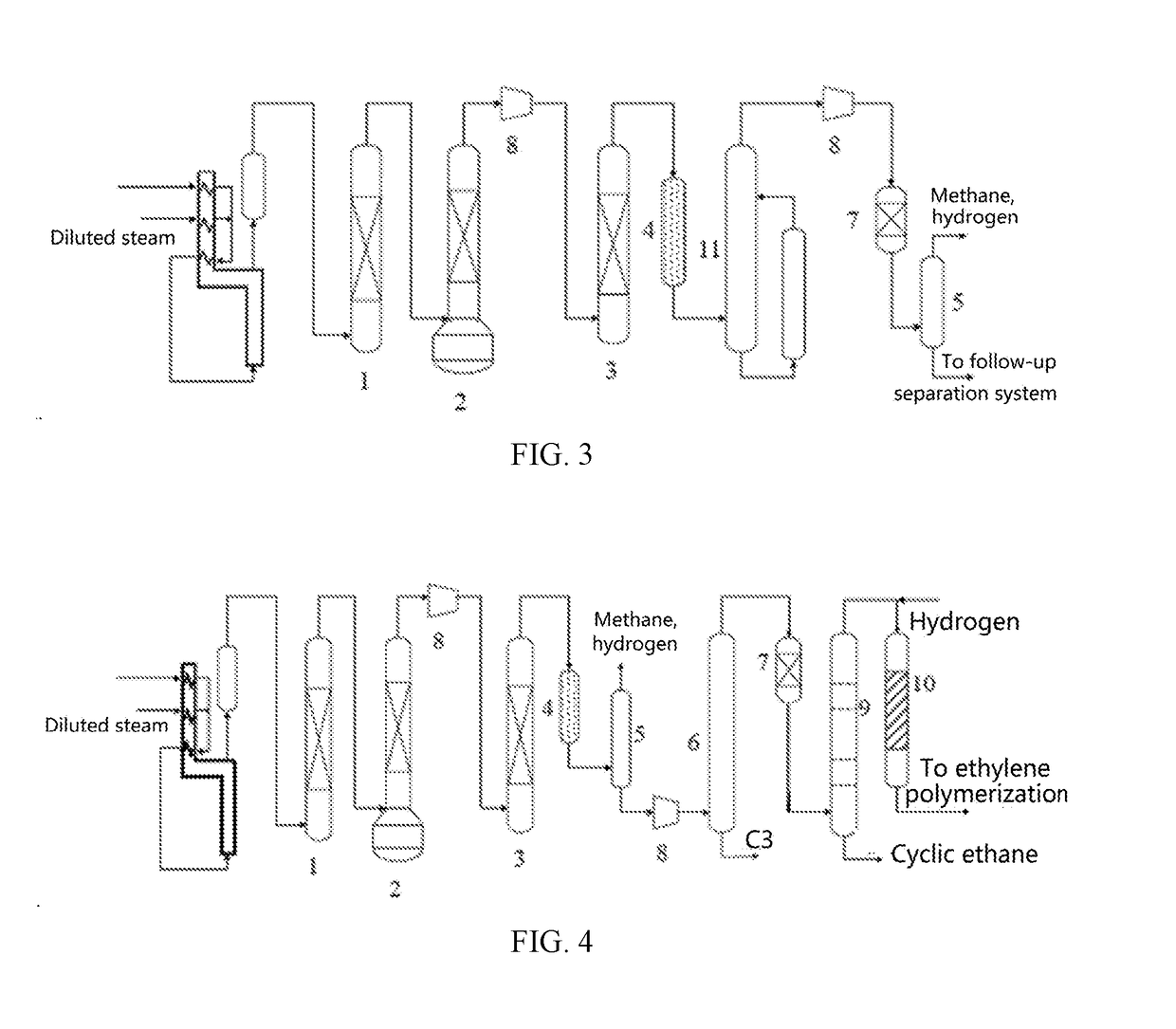Palladium-Based Supported Hydrogenation Catalyst, And Preparation Method And Application Thereof
a hydrogenation catalyst and supported technology, applied in the field of hydrogenation catalysts, can solve the problems of deteriorating the performance of polymers, complex polymerization process, and risk of explosion, and achieve excellent hydrogenation activity, ethylene selectivity and anti-coking performan
- Summary
- Abstract
- Description
- Claims
- Application Information
AI Technical Summary
Benefits of technology
Problems solved by technology
Method used
Image
Examples
example 1
[0057]500 g of a spherical α-Al2O3 carrier having Φ3.5 mm, a specific surface area of 20.0 m2 / g, a pore volume of 0.48 mL / g and a bulk density of 0.82 g / cm3 was weighed. The pore size of the carrier exhibits a bimodal pore size distribution with pore sizes of 20-50 nm and 300-500 nm, respectively.
[0058]34.12 g of 4,4′-dihydroxy-2,2′-bipyridine was dissolved in 650 mL of ethanol to obtain a solution. The above carrier was impregnated in this solution and allowed to stand for 2 hours, to allow 4,4′-dihydroxy-2,2′-bipyridine in the solution to be fully supported on the carrier. Then the solid reaction product was dried at 60° C. for 10 hours, to obtain a hydroxy-bipyridine / Al2O3 precursor.
[0059]0.37 g of Pd(NO3)2 and 0.79 g of AgNO3 were dissolved in 600 mL of deionized water and the pH was adjusted to 3.5 with an appropriate amount of nitric acid to obtain a mixed solution. The above hydroxy-bipyridine / Al2O3 precursor was added into the mixed solution, stirred for 10 minutes and allow...
example 2
[0072]500 g of a spherical carrier containing 440 g of θ-Al2O3 and 60 g of titania, having Φ2.5 mm, a specific surface area of 50 m2 / g and a pore volume of 0.75 mL / g was weighed.
[0073]6.82 g of 4,4′-dihydroxy-2,2′-bipyridine was dissolved in 600 mL of ethanol to obtain a solution. The above carrier was impregnated in this solution and allowed to stand for 8 hours, to allow 4,4′-dihydroxy-2,2′-bipyridine in the solution to be fully supported on the carrier. Then the solid reaction product was dried at 110° C. for 6 hours, to obtain a hydroxy-bipyridine / Al2O3 precursor.
[0074]0.38 g of palladium chloride and 1.72 g of chloroauric acid were dissolved in 600 mL of deionized water and the pH was adjusted to 2.5 with an appropriate amount of hydrochloric acid to obtain a mixed solution. The above hydroxy-bipyridine / Al2O3 precursor was added into the mixed solution, stirred for 1 hour and allowed to stand for 8 hours. The residual liquid was decanted, to obtain a (Pd—Au)-hydroxy-bipyridine / ...
example 3
[0085]500 g of a cylindrical carrier containing 400 g of α-Al2O3 and 100 g of magnesium oxide, having Φ4.5 mm, a height of 4.5 mm, a specific surface area of 17 m2 / g and a pore volume of 0.33 mL / g was weighed.
[0086]82.65 g of 6,6′-dihydroxy-3,3′-bipyridine was dissolved in 650 mL of ethanol to obtain a solution. The above carrier was impregnated in this solution and allowed to stand for 12 hours, to allow 6,6′-dihydroxy-3,3′-bipyridine in the solution to be fully supported on the carrier, the solid reaction product was dried at 120° C. for 4 hours, to obtain a hydroxy-bipyridine / Al2O3 precursor.
[0087]0.68 g of Pd(NO3)2 and 2.43 g of Ni(NO3)2.6H2O were dissolved in 600 mL of deionized water and the pH was adjusted to 3.4 with an appropriate amount of nitric acid to obtain a mixed solution. The above hydroxy-bipyridine / Al2O3 precursor was added into the mixed solution, stirred for 60 minutes and allowed to stand for 10 hours. The residual liquid was decanted, to obtain a (Pd—Ni)-hydro...
PUM
| Property | Measurement | Unit |
|---|---|---|
| temperature | aaaaa | aaaaa |
| mole fraction | aaaaa | aaaaa |
| temperature | aaaaa | aaaaa |
Abstract
Description
Claims
Application Information
 Login to View More
Login to View More - R&D
- Intellectual Property
- Life Sciences
- Materials
- Tech Scout
- Unparalleled Data Quality
- Higher Quality Content
- 60% Fewer Hallucinations
Browse by: Latest US Patents, China's latest patents, Technical Efficacy Thesaurus, Application Domain, Technology Topic, Popular Technical Reports.
© 2025 PatSnap. All rights reserved.Legal|Privacy policy|Modern Slavery Act Transparency Statement|Sitemap|About US| Contact US: help@patsnap.com



